Click on a year below to jump to the list of that year's students. Clicking on a student's name will jump down the page to their research summary. Return to Undergraduate Research Training Program page.
2012-13 Undergraduate Researchers
Download the 2011 Undergaduate Summer Research Symposium abstract booklet (PDF, 8.52MB)

2012-13 Undergraduate Researchers
| NAME | MAJOR | MENTOR | PROJECT |
|---|---|---|---|
|
Psychology
|
S. Roussos
|
Examining the Validity of Public Data to Describe Unincorporated Areas: A Case Study with a Rural Latino Community in California |
|
|
Biological Sciences- Microbiology and Immunology
|
R. Ortiz
|
Contribution of adipose RAS proteins to metabolic syndrome in OLETF model rats |
|
|
Biological Sciences
|
D. Ojcius
|
Chlamydia pneumoniae in Gingival Epithelial Cells Respond by Secreting Proinflammatory Cytokines |
|
|
Biological Sciences
|
M. Kitazawa
|
Developing C2C12 Cell Model for IBMPFD to Study TDP-43 and Ubiquitin Pathology |
|
|
Human Biology
|
P. LiWang
|
Optimizing Existing HIV Entry Inhibitors |
|
|
Human Biology
|
P. Brown
|
Comparing Indicators of Quality Early Care and Education from State and National Sources |
|
|
|
Examining the Validity of Public Data to Describe Unincorporated Areas: A Case Study with a Rural Latino Community in California
 Alma Andrade1, Stergios Roussos1,2, Octavio Valencia2
Alma Andrade1, Stergios Roussos1,2, Octavio Valencia2
1Center of Excellence on Health Disparities, University of California, Merced
2Alliance for Community Research and Development
Unincorporated areas nationwide house populations with socio-economic challenges correlated with many disparities in quality of life. In California, an estimated 438 unincorporated areas house over 7 million people, or approximately 1 in 5 Californians. Publicly available data sources are important first steps in the analysis of the health of unincorporated areas. However, limited research exists to understand the validity of public secondary data for unincorporated communities. A case study using a small rural town in the San Joaquin Valley of California (Lost Hills) was conducted to examine the validity of public data in describing the population.
Existing critiques of the U.S. Census and the American Community Survey (ACS) were used to identify threats to their internal validity. Subsequently, these threats were examined using the data available for Lost Hills to understand their relevance for this unincorporated area. The findings indicated that both the Census and the ACS may undercount the overall population of Lost Hills, in particular the Latino population. Limited English proficiency and lack of citizenship also threaten the valid count of the largely immigrant and migrant population of Lost Hills. The data and methods of the ACS may offer a more valid representation of this unincorporated community. These findings may be generalizable to other small communities with a proportionally larger percentage of Latino residents.
Contribution of adipose RAS proteins to metabolic syndrome in OLETF model rats
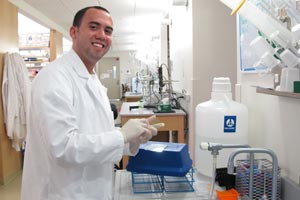 David N. Araiza1, Jacqueline N. Minas1, Ruben Rodriguez1, Daisuke Nakano2, Akira Nishiyama2, and Rudy M. Ortiz1
David N. Araiza1, Jacqueline N. Minas1, Ruben Rodriguez1, Daisuke Nakano2, Akira Nishiyama2, and Rudy M. Ortiz1
1School of Natural Sciences, University of California, Merced
2Department of Pharmacology, Kagawa Medical University, Miki-cho, Kita-gun, Kagawa 761-0793, Japan
Activation of the renin-angiotensin system (RAS) has been shown to contribute to metabolic syndrome. Hyptertension is a key component of metabolic syndrome and is regulated by RAS. A preferable model used to evaluate the effects of such conditions is the Otsuka Long-Evans Tokushima Fatty (OLETF) rat because their pathogenesis closely resembles that of the progression of human insulin resistance, metabolic syndrome, and type 2 diabetes. However, the contribution of adipose RAS to metabolic syndrome is not yet well defined.
To address the hypothesis that adipose RAS activation is increased with insulin resistance, rats were divided into two groups (n=10-12/group): 1) lean strain-control LETO 2) Obese insulin resistant OLETF. Systolic blood pressure (SBP) was measured weekly for 24 weeks and insulin resistance index (IRI) was determined at 9 and 24 weeks. Tissue samples were collected from each group (n=5-6/group) at 15 and 24 weeks. Mean SBP from OLETF was 28% and 27% greater compared to that of the LETO after 15 and 24 wk respectively. Mean IRI was greater at both time periods as well, and we exacerbated in 24 wk OLETF compared to 15 wk. By 24 wk, adipose angiotensinogen (angiotensin precursor) expression had increased in 24 wk OLETF suggesting that activation of adipose RAS was increased. The data suggest that increased activation of RAS may contribute to the increased metabolic disorders (SBP and IRI) commonly associated with metabolic syndrome.
Chlamydia pneumoniae in Gingival Epithelial Cells Respond by Secreting Proinflammatory Cytokines
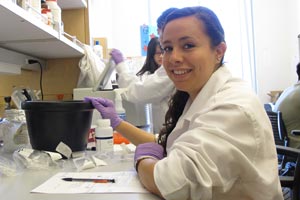 Yotzelin Cervantes, Ye Zhu, David Ojcius
Yotzelin Cervantes, Ye Zhu, David Ojcius
School of Natural Sciences, University of California, Merced
Chlamydia is one of the world’s most common sexually transmitted disease as well as the leading cause of blindness. Recently there has been more of an interest in Chlamydia pneumoniae, an intracellular bacteria that infects humans and has been known to cause lung complications, bronchitis, and pharyngitis. However, little is known about whether if C. pneumoniae can cause oral disease.
Chlamydia infections are usually characterized by inflammation, which is an innate immune response. NLRP3 inflammasome is one of the most well studied type of inflammasome due to its keen immune response to microbial molecules. NLRP3 inflammasome triggers the secretion of proinflammatory cytokines acting as a defense against infection. Knowing this, there is a belief to be a connection between NLRP3 inflammasomes and gingival epithelial cells. Gingival epithelial cells (GEC) are beneficial when studying the oral mucosa and in order to understand if C. pneumoniae is causing oral diseases we will study infected GEC.
Through this study we hope to see that the C. pneumoniae will adhere to the GEC which then can help determine if C. pneumoniae will activate NLRP3 inflammasome during infection. Respectively, there is an expectation to see growth inhibition of C. pneumoniae in the gingival epithelial cells through an increase of proinflammatory cytokines.
Developing C2C12 Cell Model for IBMPFD to Study TDP-43 and Ubiquitin Pathology
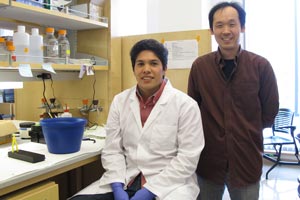 Julio Flores, Carlos Rodriguez-Ortiz, Masashi Kitazawa
Julio Flores, Carlos Rodriguez-Ortiz, Masashi Kitazawa
School of Natural Sciences, University of California, Merced
Inclusion body myopathy associated with Paget’s disease of bone and frontotemporal dementia (IBMPFD) is a degenerative genetic disorder caused by mutations in the valosin-containing protein (VCP) gene. Approximately, 80% of patients carrying VCP mutations develops inclusion body myopathy. Although the molecular mechanisms underlying IBMPFD pathology remain unknown, mislocalization of TAR DNA binding protein 43 (TDP-43) in cytoplasm and the accumulation of ubiquitinated proteins have been implicated as important culprits in the mutant VCP-mediated myodegeneration. We sought to investigate mechanisms by which disease-associated mutations in VCP triggered TDP-43 redistribution to cytoplasm and the accumulation of ubiquitin inclusions in the cell. Currently, there is no in vitro model that recapitulates the disease phenotypes. In this study, we developed a cell culture model overexpressing human wildtype or disease-relevant mutant VCP. Murine myoblast C2C12 cells were used as a model for skeletal muscle cells and transfected with disease-causing mutant forms of human VCP, R155H, A232E, and a dominant-negative mutation, K524A. We established optimal conditions for the transfection in C2C12 cells and examined pathological hallmarks using immunocytochemical and biochemical approaches, both of which were optimized in the laboratory.
Our preliminary results suggest that mutant VCP expressions slightly altered TDP-43 localization in the cytoplasm and aggregation of ubiquitinated proteins, but accurate comparisons to wildtype forms have yet to be quantified. Nuclear and cytoplasmic fractionations were achieved, and will be used to analyze distribution of TDP-43 and ubiquitin aggregates. Taken together, we have developed optimal techniques that will be used to study IBMPFD pathology in C2C12 cells.
Optimizing Existing HIV Entry Inhibitors
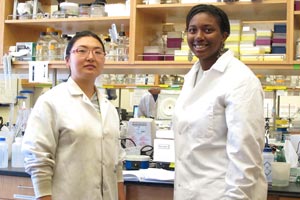 Christiane Okafor-Ize, Jie Xue, Patricia LiWang
Christiane Okafor-Ize, Jie Xue, Patricia LiWang
School of Natural Sciences, University of California, Merced
HIV entry inhibitors have been a groundbreaking discovery in the search for successful HIV drugs, and in particular to stop initial infection. Currently, Fuzeon (T20) is a drug approved by the FDA for treating and decreasing viral load in HIV-infected persons, which has the mechanism of binding to HIV and preventing HIV entry into cells. Cell entry is mostly due to two major glycoproteins on HIV-1’s surface: gp41 and gp120. Since the introduction of T20, a “first-generation inhibitor”, many laboratory and wild-type strains of HIV have become resistant to this specific inhibitor. This has led to further studies implementing different proteins or molecules to identify a stronger inhibitor to block HIV entry.
One method of stopping HIV is by blocking gp120. Griffithsin, a protein derived from algae, has been discovered as a very potent entry inhibitor. It acts by targeting the glycoprotein gp120, and, works effectively on its own, or coupled with another inhibitor. In our previous study, we discussed the success of the chemokine variant inhibitor 5P12-linker-C37. By blocking HIV entry into the host cell by binding gp41 and host cell proteins, these powerful yet inexpensive inhibitors potentially provide a remedy for the ever-increasing number of HIV infections. With the recent success of a new third generation gp41-binding fusion inhibitor, T1144 (Pan, C., Cai, L. (2011) Journal of Biological Chemistry), newer inhibitors seem to carry potential for an improved anti-HIV drug. By linking Griffithsin with T-1144, and 5P12 RANTES with T-1144, it is hypothesized that HIV inhibition could be improved.
Comparing Indicators of Quality Early Care and Education from State and National Sources
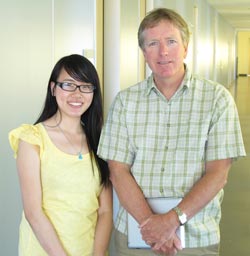 Catherine Vu and Paul Brown
Catherine Vu and Paul Brown
Center of Excellence on Health Disparities, University of California, Merced
Research shows that children who experience higher quality early care and education programs (ECE) perform significantly better in school than do children from lower quality programs. In order to objectively assess and improve ECE, a quality rating and improvement system (QRIS) with research-supported quality indicators is crucial. California is in the process of developing QRIS, following 23 states nationwide, which have already adopted statewide QRIS. A comparative analysis of national and state indicators was conducted to understand the potential importance of existing indicators for California's QRIS. Indicators from a 2010 national compendium of 23 states' QRIS and California's CAEL QIS 2010 report were organized into a matrix and reviewed to identify similarities and differences between California and other states. Five of California's proposed indicators (“ratios and group size,” “teaching and learning,” “family involvement,” “staff education and training,” and “program leadership”) matched 12 of 13 indicators identified nationally. A nationally-compiled indicator on “accreditation by a national accrediting body” was not included in the California set.
One potential strength in the California QRIS that was largely absent nationwide was the definition of quality criteria for different types of ECE (preschool and family child care). This comparison of nationwide and California indicators of quality ECE demonstrated that the majority of ECE quality indicators were consistent between the two reports. Results from this study may inform conversations on the development of California's QRIS and application of the quality indicators to county- and city-level efforts to ensure high quality early care and education.
2011-12 Undergraduate Researchers

2011-12 Undergraduate Researchers
| Name | Major | Mentor | Project |
|---|---|---|---|
|
Biological Sciences, Microbiology and Immunology
|
J. Manilay
|
Differentiation of Insulin-Producing Cell Clusters from Mouse Embryonic Stem Cells
|
|
|
Psychology
|
L. Hirst
|
Omega-3 fatty acids and their role in biological membranes: Possible reasons for beneficial health outcomes
|
|
|
Biology (emphasis on development)
|
A. Aguilar
|
Studying Patterns of Mitochondrial DNA and Major Histocompatibility Complex Variation in the Red Hills Roach (Cyprinidae: Lavinia symmetricus ssp) Populations
|
|
|
Sociology
|
I. Beattie
|
Underrepresented Students’ Success in STEM Majors
|
|
|
Biological Sciences (emphasis on molecular and cell biology)
|
R. Ortiz
|
Akt/Protein Kinase B Expression Increases with High Glucose Supplementation in Insulin Resistant OLETF Rats
|
|
|
Biological Sciences (emphasis on human biology)
|
S. Roussos
|
Hmong cultural practices, traditions, and beliefs to prevent morbidity and mortality: A critical review
|
|
|
Psychology and Cognitive Science
|
S. Weffer
|
Impacts of Foreclosure on Efficacy and Perceptions of Barriers to Community Success in South Merced and Planada.
|
|
|
Molecular and Cell Biology
|
A. LiWang
|
2H and 13C NMR Analysis of Ethanol: Isotopic Markers of Biological and Process Origins of Single-Malt Scotches
|
Differentiation of Insulin-Producing Cell Clusters from Mouse Embryonic Stem Cells
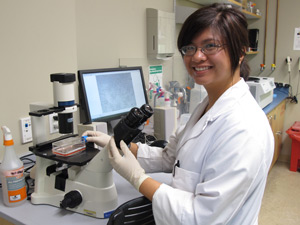 Christa D. Caneda and Jennifer O. Manilay
Christa D. Caneda and Jennifer O. Manilay
In Type 1 diabetes, insulin-producing pancreatic cells, or beta cells, are destroyed by an autoimmune response. Current clinical treatments are limited to indefinite insulin replacement therapy, pancreas transplantation, and beta islet transplantation. To restore glucose regulation in a less invasive way, the replacement of beta cells by inducing embryonic stem cell (ES cell) differentiation to insulin-producing cell clusters (IPCCs) has been proposed.
We hypothesize that cell culture and differentiation of embryonic stem cells to IPCCs will reproduce the insulin-producing capacity of healthy beta cells in an adult mouse. Over the course of 6 weeks, three mouse-derived cell cultures were grown and maintained: the insulinoma cell lines, 832/3 and 832/13; the embryonic fibroblast cell line, STO; and the clonal ES cell line, ES-D3. These cell lines were cultured through the practice of routine subculture, thawing, and freezing protocols. Insulinoma cell stocks were successfully expanded, and will be utilized as a positive control for comparison with IPCCs. ES cells and STO cells (which are feeder cells for ES cells) continue to be cultured.
To direct differentiation to IPCC, ES cells will be resuspended by trypsinization and then transferred to differentiation media. Analysis of differentiation will be conducted through enzyme-linked immunosorbent assay (ELISA) to detect levels of c-peptide, a byproduct of insulin production, to distinguish between de novo insulin synthesis and adsorption of insulin-rich culture media. These protocols will contribute to the overall goals of achieving islet cell development by embryonic stem cell differentiation.
Christa is a third-year Regents Scholar from Sacramento, California. She is a Biological Sciences major, with her studies emphasizing on Microbiology and Immunology. She is actively engaging in career exploration for a suitable lifelong environment for her passion towards biology, with current considerations in pharmacy and research. When she is not sporting her lab coat to perform cell culture, she enjoys the creative pastimes of drawing, painting, and theater. She also currently participates in the UC Merced Intervarsity Christian Fellowship and the UC Merced Pre-Pharmacy Club.
- Summer presentation slides (PDF)
- Summer presentation video (YouTube: page will open in new window or tab)
- Publication: Proceedings of the National Conference of Undergraduate Research 2012
Omega-3 fatty acids and their role in biological membranes: Possible reasons for beneficial health outcomes
 Stephanie Chen and Linda S. Hirst
Stephanie Chen and Linda S. Hirst
Docosahexaenoic acid (DHA), an ω-3 fatty acid, is known for being an essential dietary nutrient for nerve tissue growth and function. Numerous clinical studies have also shown that DHA deficiencies are associated with disorders such as attention deficit hyperactivity disorder, cystic fibrosis, unipolar depression and aggressive hostility. Consequently it is important to understand how ω-3 fatty acids contribute to the development of the central nervous system, but not much is known about how polyunsaturated fatty acids are transported to the cells of the nervous system and incorporate into the membrane. We are particularly interested in studying the link between ingestion of ω-3 lipids and their observed dietary benefits.
This study uses fluorescence microscopy and atomic force microscopy to observe phase separation phenomena (such as lipid rafts/domains) in membranes containing DHA and other lipids. Membranes are prepared by the electro-formation method to generate giant unilamellar vesicles, synthetic models for the cell membrane. Previous work has shown that saturated lipids in the membrane pack preferentially with cholesterol to form nano-scale domains with a variety of proposed important roles in trans-membrane protein function. We expect that an increase in polyunsaturated lipids in the membrane, such as DHA, will modify the structure and/or distribution of the membrane domains. This molecular level study may provide key information about how ingestion of ω-3 lipids can produce health benefits.
Stephanie Chen is currently a third year undergraduate student at the University of California, Merced. She is pursuing a bachelor’s degree in psychology with a minor in art. She plans on pursuing graduate school upon completing her degree. Some career interests, that Stephanie is exploring, are: academic advising, research, teaching, and forensic testimony. She is now a part of the Center of Excellence on Heath Disparities’ Undergraduate Research Training Program. She works in a biophysics lab in order to explore her interests in biology and physics.
- Summer presentation slides (PDF)
- Summer presentation video (YouTube: page will open in new window or tab)
Studying Patterns of Mitochondrial DNA and Major Histocompatibility Complex Variation in the Red Hills Roach (Cyprinidae: Lavinia symmetricus ssp) Populations
 Morrell Chhay and Andy Aguilar
Morrell Chhay and Andy Aguilar
The recently discovered small population of the Red Hills roach (Cyprinidae: Lavinia symmetricus ssp) has had previous morphological and phylogenic studies done to determine the degree of isolation for this subspecies. However, studies to determine genetic diversity in the major histocompatibility complex (MHC) in these small populations has yet to be done and can provide insight into the future persistence of these populations.
We hypothesized that the small populations of the Red Hills roach will have a low amount mitochondrial DNA and MHC diversity due to their small population sizes and their isolations. DNA was extracted with fin clips and the Qiagen DN-easy kit. Portions of the cytochrome B and the three MHC genes: DAB1, UAA, and OL93-139/OL93-23 were targeted with polymerase chain reaction (PCR) using established primers.
Data for MHCs were inconclusive for because all three MHC primers had failed to produce consistent results. The OL93-139/OL93-23 primers produced multiple bands when amplified and the UAA primer fail to produce any bands. The DAB1 primer only worked in some individual samples and the trends that correlate to the success of the primer in certain samples is unclear. The cytochrome B primer produced useable results showing variation in the mitochondrial DNA in the Red Hill roach populations. Our data suggests that the Red Hills Roach is a distinct subspecies in the California roach species complex.
Morrell Chhay is a continuing third year student at UC Merced and is majoring in Biology with an emphasis in development. For his career goals he is keeping an open mind and for now is pursuing a career involving general health and medicine. Aside from academics he takes part in the UC Merced Sports Shooting Club and volunteers in emergency room at Catholic Healthcare West’s Mercy Medical Center. On the recreational side, Morrell enjoys staying active with running, hiking and biking.
- Summer presentation slides (PDF)
- Summer presentation video (YouTube: page will open in new window or tab)
Underrepresented Students’ Success in STEM Majors
 Rubinpreet Kaur and Irenee Beattie
Rubinpreet Kaur and Irenee Beattie
Science, Technology, Engineering, and Mathematic (STEM) fields are amongst the most popular choices of major for underrepresented students (e.g. women, first generation, and minorities). A common characteristic for successful students in STEM fields is communication. In this study, we are looking for a relation between communications during high school with parents and college with faculty amongst underrepresented STEM students. Increased times of communication per semester between faculty and students can be a result from communicating openly with parents during high school about career planning and higher education. We conducted an online survey to a stratified random sample at a university.
Currently, the results show that women minorities communicated more with their parents during high school than first generation men and non-first generation men and women did. Further analysis could possibly show higher Grade Point Averages amongst these women when looking at a factor of academic success. Some underrepresented students, such as first-generation, that had working parents during high school probably communicate less to faculty than others do. A mentoring program at universities can help students that did not openly converse with parents during high school learn to communicate with professors.
Rubinpreet Kaur is a fifth year student at the University of California, Merced. She has obtained a Bachelor of Arts in Sociology and will be completing final courses for her minor this upcoming academic year. Rubinpreet plans to attend law school and study criminal law. Her interests include cooking, dancing, and mentoring students into higher education.
Rubinpreet is currently working with Dr. Irenee Beattie, through the Center of Excellence on Health Disparities, as a research intern. She is looking at trends in underrepresented students in fields of Sciences, Technology, Engineering, and Mathematics.
- Summer presentation slides (PDF)
- Summer presentation video coming soon
Akt/Protein Kinase B Expression Increases with High Glucose Supplementation in Insulin Resistant OLETF Rats
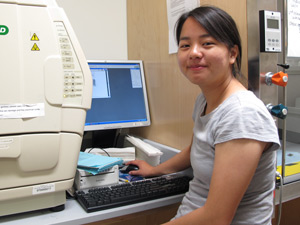 Lia Lee, Irina Popovich1, Ruben Rodriguez1, Jose Viscarra1, Daisuke Nakano2, Akira Nishiyama2, Rudy M. Ortiz1
Lia Lee, Irina Popovich1, Ruben Rodriguez1, Jose Viscarra1, Daisuke Nakano2, Akira Nishiyama2, Rudy M. Ortiz1
Akt/protein kinase B plays a significant role in the insulin signaling pathway of peripheral tissues. Disruption of Akt/protein kinase B in skeletal muscle is associated with a decrease in glucose uptake. Inefficient glucose uptake can lead to insulin resistance, contributing to the development and progression of cardiovascular disease.
Angiotensin receptor blocker (ARB) treatments can improve insulin sensitivity and decrease the augmentation of cardiovascular conditions. However, the contribution of angiotensin receptor activation to insulin sensitivity in the heart remains unclear.
In addition, cardiac insulin signaling with respect to Akt phosphorylation is yet to be investigated. Using an insulin resistant model, we hypothesized that the action of Akt is increased with high glucose. After six weeks, hearts were collected from 5 groups of rats (14 wks old): 1) LETO control, 2) OLETF, 3) OLETF+ARB (10 mg olmesartan/kg/d), 4) OLETF+high glucose (HG; 5% in water) and 5) OLETF+ARB+HG. Protein content of cardiac Akt was analyzed by Western blotting. Blood and plasma insulin levels were measured to calculate IR index. Ratio of phosphorylated Akt to total Akt content increased with high glucose suggesting glucose increases the activation of Akt. However, treatment with ARB did not change the activation in rats on either normal or high glucose-supplemented diets. This suggests that the activation of angiotensin receptor does not contribute to the activation of Akt in the heart during an insulin resistance.
Lia Lee is a fourth year student from Fresno, Ca. She is majoring in molecular and cell biology and hopes to pursue nursing after she leaves UC Merced. She enjoys reading books and seeing new places!
- Summer presentation slides (PDF)
- Summer presentation video coming soon
Hmong cultural practices, traditions, and beliefs to prevent morbidity and mortality: A critical review
 Bouapanh Lor and Stergios Roussos1 MPH, PhD
Bouapanh Lor and Stergios Roussos1 MPH, PhD
After the Hmong migrated from Southeast Asia to the United States in the early 1970s, adaptation and assimilation into the Western culture has been a continuous struggle, especially towards Western medicine. This study aims to determine Hmong cultural practices or traditions that are used to prevent diseases and maintain overall good health. If these practices could be identified, they could be applied towards building trust in Western medicine.
Interviews were conducted with 12 key informants about cultural practices used to prevent diseases and maintain good health. Each interview was assessed individually to examine key concepts about health practices in the Hmong culture. Eighty three percent of the interviews identified herbs, herbal teas, and nutrition such as growing their own foods, as ways that the Hmong stay healthy and try to prevent diseases. Seventy-five percent of the interviews said that if someone were dying from an illness, most Hmong people would take that person to a shaman or try home herbal remedies; Western medicine would be the last resort. Ninety-two percent of those interviewed agreed that individuals who are considered trustworthy (preferably Hmong) and educated about vaccines or drugs, or visual proof would be the only way to convince or change behaviors of the Hmong public.
This study suggests there is a need for cultural liaisons that are trusted and educated about vaccines and drugs to reach out to the Hmong public about health issues that specifically target them. More research is needed on the effectiveness of Hmong cultural health practices.
Bouapanh Lor first moved to Merced at the beginning of her sophomore year in high school from Fresno. She attended Golden Valley High School and graduated in 2007. That following fall semester, she attended Merced College as an undeclared major. After a year, she discovered her enthusiasm for the sciences and declared biology as her major. In the spring of 2011, she transferred to UC Merced as a biology major with an emphasis in human biology where she still currently attends. Her future plans include continuing her education in an institution where she can pursue becoming a physician’s assistant.
- Summer presentation slides (PDF)
- Summer presentation video (YouTube: page will open in new window or tab)
Impacts of Foreclosure on Efficacy and Perceptions of Barriers to Community Success in South Merced and Planada.
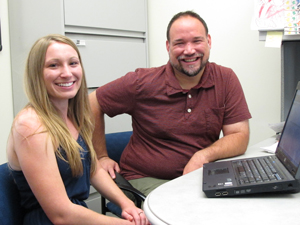 Alex Parnell and Simón E. Weffer
Alex Parnell and Simón E. Weffer
Neighborhood collective efficacy, which is defined as a common intent to reduce the existing problems within a neighborhood, is dependent on social cohesion and social control. It can be disrupted by instability within the neighborhood. Previous studies by Sampson et al (1997) have found a relationship between increased collective efficacy and a decrease in violence as well as the negative effects of residential instability. One of the most impactful factors on neighborhood stability in the last 5 years has been the increase in foreclosures.
Foreclosures clearly cause a shift in neighborhood stability. The literature has not examined in depth the link between foreclosures and neighborhood efficacy. If people have negative ideas of foreclosure, these views should be reflected in decreased efficacy. Using surveys of 127 participants from South Merced and Planada from 2007 to 2010, we examine foreclosures, neighborhood efficacy, and perceptions of barriers to community success.
We examine what the average efficacy score is for individuals based on their responses on the impacts of foreclosure in their community. The most common response in relation to the questions: 1) what are the barriers to improving the community; 2) what empty houses (as a result of foreclosure) do to the neighborhood were crime and safety. However, only 2 of the 127 people surveyed mentioned foreclosure as a barrier to community success. Therefore, people are concerned with crime and safety within their neighborhoods, but may not be directly aware of foreclosure as a factor.
Alex Parnell is currently a senior at the University of California, Merced. Alex entered the university as a psychology major, but during her junior year decided to broaden her education by adding cognitive science as a second major, with a minor in sociology. Her future goals include attending graduate school in the fall of 2012 and then to pursue a career as a clinical psychologist.
- Summer presentation slides (PDF)
- Summer presentation video coming soon
2H and 13C NMR Analysis of Ethanol: Isotopic Markers of Biological and Process Origins of Single-Malt Scotches
 Dusty Ventura , M P Meyer and A LiWang
Dusty Ventura , M P Meyer and A LiWang
Isotopic analysis via NMR is rapidly becoming a powerful tool in the analysis of the biological and process origins of foods. The principal hypothesis behind this analysis is that food and drink production processes fractionate isotopes in a distinct manner which can be traced to physical origins. Here, we propose to utilize the analysis of four isotopic quantities to gain insight into the differences among single-malt scotch whiskeys. The geographical origins of the raw barley used to manufacture malt will partially determine the ratio of 13C in the methylene and methyl groups of the product of fermentation, ethanol. Processes, such as distillation, are likely to have some additional effect upon total heavy isotope inclusion. The regional geographical source of water used during the milling process in the production of scotch whiskey is likely to determine the intramolecular 2H ratios at the methylene and methyl groups in ethanol. Total deuterium content is likely to reflect the geographical origin and distillation process of raw barley.
We propose to leverage NMR analysis of the 13C and 2H content at the methyl and methylene groups in ethanol for scotch whiskeys originating from each of the geographically distinct whisky production regions in Scotland. Principle component analysis will be used to generate isotopic markers capable of distinguishing the geographical origin of single-malt scotch whiskys. This research has the prospect of increasing our knowledge of how geochemical signatures are transferred into food systems, as well as increasing the effectiveness and accuracy of food provenance determination techniques.
Dusty Ventura began her academic career by studding biotechnology at Merced Community College, which was completed in 2009. She is now a senior at the University of California, Merced, currently doing research in enology and NMR analysis in the lab of Dr. Matthew P. Meyer and Dr. Andy LiWang. Dusty is particularly interested in nanobiotechnology, and plans on pursuing a Ph.D. in that field while at UC Merced.
- Summer presentation slides (PDF)
- Summer presentation video (YouTube: page will open in new window or tab)
2010-11 undergraduate researchers

2010-11 Undergraduate Researchers
| Name | Major | Mentor | Project |
|---|---|---|---|
|
Cognitive Science
|
M. Pallavicini
|
Prior Use of Telemedicine and Challenges among California Specialty Physicians.
|
|
|
Anthropology
|
M. Pallavicini
|
Evaluation of California Physician Specialists Concerns About Telemedicine Based on Their View of Telemedicine.
|
|
|
Psychology
|
S. Roussos
|
Mapping Education in Supervisorial District of Merced County. Phase I: Descriptive Account of GIS Usage in Merced County.
|
|
|
Sociology, Political Science
|
S. Weffer
|
The Relationship Between Residential Stability and Felt Community Efficacy, 2008 - 2009.
|
|
|
Cognitive Science
|
R. Ortiz
|
Angiotensin Receptor Blockade Decreases Hepatic Triglyceride Content and Reduces Retroperitoneal Fat Deposition Following Increased Glucose Intake in a Model of Insulin Resistance.
|
|
|
Human Biology
|
S. Roussos
|
Mapping the Health Indicators Suggested by the 5 Board of Supervisors in Merced County.
|
|
|
Human Biology
|
P. LiWang
|
Mutation in C37 Region of Potent HIV Inhibitor Griff37.
|
|
|
Immunology, Microbiology
|
J. Choi
|
Hepatitis C Virus.
|
|
|
Biological Sciences, Human Biology
|
R. Ortiz
|
Decreased CD 36 Expression in Insulin Resistant Rats.
|
|
|
Human Biology
|
R. Ortiz
|
Increasing GLUT4 Expression in Fasting Elephant Seals.
|
Prior Use of Telemedicine and Challenges among California Specialty Physicians.
 Ruth Adams, Emely Heras, Maria Pallavicini, Nella Van Dyke and Joseph Norris
Ruth Adams, Emely Heras, Maria Pallavicini, Nella Van Dyke and Joseph Norris
Telemedicine is defined as the delivery of health services via remote telecommunications. This includes interactive consultative and diagnostic services. One goal of telemedicine is to provide specialty care to underserved populations from a distant point. UC Merced in partnership with Valley Telehealth has established six telemedicine sites across the San Joaquin Valley. In order to understand the barriers that specialists confront using telemedicine, surveys were sent to 11,887 California licensed specialists in 27 medical specialties across California via email addresses available on a public database. Thirteen questions were used to address prior knowledge of telemedicine, use of telemedicine, opinion on telemedicine, and concerns with telemedicine. We tested the hypothesis that specialty physicians with previous experience using telemedicine increases the likelihood of using telemedicine again in the future. 292 complete surveys were returned via email. 202 respondents reported using telemedicine previously and 90 reported never using telemedicine previously. 10 out of the 202 respondents reported using telemedicine previously but were unlikely or very unlikely to use telemedicine again. 192 out of the 202 respondents reported being very likely or likely to use telemedicine again. 95% of specialty physicians with previous experience using telemedicine were very likely or likely to use telemedicine again in the future. Previous experience using telemedicine increases the likelihood of telemedicine continuation in the future.
Evaluation of California Physician Specialists Concerns About Telemedicine Based on Their View of Telemedicine.
 Emely Heras, Ruth Adams, Maria Pallavicini, and Nella Van Dyke
Emely Heras, Ruth Adams, Maria Pallavicini, and Nella Van Dyke
Telemedicine allows practitioners to consult and review the records of distantly located patients. These interactions can be used for diagnosis, case management, patient screening, consultation and store and forward imaging, which also include video conferencing. One of the major contributors to increasing health disparities in California is the lack of access to physicians, particularly physician specialists in rural and underserved regions. While telemedicine is and can be deployed in these regions, it is important to identify strategies to increase the number of physician specialists that use telemedicine. We hypothesized that physician specialist opinions positively correlate with the likelihood they would incorporate telemedicine into their daily practice. Data were collected using a thirteen-question survey, which was distributed electronically to California physician specialists identified through California Licensing board. Approximately 11,887 physician specialists were targeted via email to complete the survey. The questions focused on overall opinion, experience, and concerns that may apply to the specialists understanding of telemedicine. There were a total of 292 physician respondents, representing 27 medical specialties. The data suggest that physician specialists with a negative opinion about telemedicine are unlikely to use it in the future. Furthermore the primary concerns about use of telemedicine of physicians with a negative opinion were similar to those who viewed it positively and use it in their practice. Primary concerns include compromising quality of care and technical challenges. These data will be useful to develop strategies to overcome the barriers to using telemedicine.
Mapping Education in Supervisorial District of Merced County. Phase I: Descriptive Account of GIS Usage in Merced County.
 Elaine S. Lai1, Johnny Moua1 and Steve Roussos2
Elaine S. Lai1, Johnny Moua1 and Steve Roussos2
Using Geographic information system (GIS), this student-led initiative worked with the community to examine the geographical distribution of resources that may contribute to the disparities on community health and development. Community engaged scholarship (CES) is used to actively engage community stakeholders as partners and scholars in conducting the needs assessment for Merced County.
There are three main steps to CES GIS: (1) build an infrastructure for CES GIS campus and in the community, (2) interview key community informants and compile a list of important health and education indicators, and (3) outline procedures for the implementation of a CES GIS mapping.
To create an infrastructure, people and resources within the campus and the community were located. Twenty undergraduate students were recruited to assist the project. The Board of Supervisors (BoS) played a critical role in the development of the CES GIS project. The concerns of the BoS fell into three categories: education, health and economic development. Merced County Office of Education facilitated decision and data collection for schools. Merced County Public Health Department facilitated decisions and data collection for public health indicators. City and County GIS experts facilitated GIS training and provided resources for students to map the selected indicators. Conclusion: From the findings it can deferred that the community input is invaluable in developing the CES GIS project as they offered wisdom and resources that would otherwise be inaccessible. Next steps include: training new student leaders, developing a formal GIS course with credit and continuing to engage community stake holders in the project.
The Relationship Between Residential Stability and Felt Community Efficacy, 2008 - 2009.
Rafael A. Maravilla and Simón Weffer-Elizondo
Social cohesion and social control are important to the development of felt community efficacy. Community efficacy can lead to the development and introduction of social programs which may alleviate some of the health disparities which arise in low socio-economic status communities. It is perceived that residential stability increases felt community efficacy. Previous research has focused on communities located within the urban centers of the United States. Our research will focus on low socio-economic status in a more rural setting, Planada and South Merced in California, which has not received much attention from the research community. Data was collected using a semi-structured survey instrument by way of one on one interviews with respondents. The instrument included 11 closed-ended questions using a 5 point Likert scale to quantify responses. Our preliminary findings show that in our rural setting we found that felt community efficacy does not necessarily increase with higher rates of residential stability as it does in communities located in larger urban centers. An extensive literature review was also conducted in order to hypothesize possible findings of our study. We also found that felt community efficacy was greater in the smaller town of Planada, than it was in South Merced which is larger and more populated. In addition our data showed that there was no clear direct relationship between residential stability and efficacy, despite theoretical predictions.
Angiotensin Receptor Blockade Decreases Hepatic Triglyceride Content and Reduces Retroperitoneal Fat Deposition Following Increased Glucose Intake in a Model of Insulin Resistance.
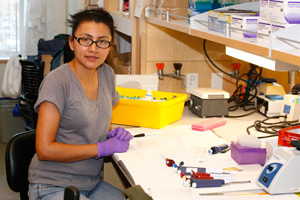 Priscilla Montez1, Ruben Rodriguez1, Jose Viscarra1, Daisuke Nakano2, Akira Nishiyama2, Rudy M. Ortiz1
Priscilla Montez1, Ruben Rodriguez1, Jose Viscarra1, Daisuke Nakano2, Akira Nishiyama2, Rudy M. Ortiz1
High glucose intake can result in the progression of diabetes & obesity. Increased lipid concentrations in circulation and in tissues have been shown to impair insulin signaling, which may manifest insulin resistance, and ultimately diabetes. Treatment with an angiotensin receptor blocker (ARB) may improve impaired insulin signaling, and thus decrease the potential for developing diabetes. Because excessive glucose intake can exacerbate the deposition of adipose, and subsequently, plasma lipid levels in insulin resistant conditions, the purpose of this study was to assess the benefits of ARB treatment on lipid metabolism as it relates to fat deposition in a model of insulin resistance on a high glucose supplemented diet. We examined the effects of chronic (6 wks) ARB treatment on Otsuka Long Evans Tokushima Fatty (OLETF) rats, using Long Evans Tokushima Otsuka (LETO) rats as the lean, control strain. To test our hypothesize that angiotensin receptor blockade decreases hepatic triglyceride content following increased glucose intake in a model of insulin resistance we used the following groups of rats: 1) LETO control (14 wks), 2) OLETF at 8 wks, 3) OLETF at 14 wks, 4) OLETF + ARB (10 mg olmesartan/kg/d in the diet x 6 wks), 5) OLETF + high glucose (HG; 5% in water x 6 wks), and 6) OLETF + ARB + HG. After 6 wks of treatment, plasma triglycerides, glycerol, free fatty acids (NEFA), and ß-hydroxybutyrate levels along with liver triglyceride content were measured. ARB treatment in HG reduced plasma triglyceride, plasma glycerol, NEFA levels and liver triglyceride content suggesting that blockade of angiotensin receptor reduces hepatic triglyceride production. ARB treatment in HG also increased plasma ß-hydroxybutyrate suggesting that fatty acid oxidation is increased. The data demonstrate a profound benefit from ARB treatment on lipid metabolism and fat deposition suggesting that besides the antihypertensive effects of ARB treatment, ARB can also improve the condition of metabolic syndrome by improving the lipid profile and reducing adiposity.
Mapping the Health Indicators Suggested by the 5 Board of Supervisors in Merced County.
 Johnny Moua1,Elaine Lai1 and Steve Roussos1,2
Johnny Moua1,Elaine Lai1 and Steve Roussos1,2
Access to health care services is a strong predictor of life expectancy and a strong indicator of community health. Using geographic information system (GIS), location of potential health indicators within supervisorial districts of Merced County will be easily visualized on an interactive level allowing for relationship, trends and patterns to be monitored. From our understanding, a clear baseline has not been created for Merced County in measuring a change. Our research question is to see how the 5 board of supervisors in Merced County will change the allocation resources such as money and location of health services in their districts to improve population health by using GIS to understand health disparities in Merced County in their districts. From the documentary Unnatural Causes, “place maters” is depicted since where a person lives determines whether one can access health care or not and ultimately influencing how long they will live. Other counties such as Contra Costa County have replicated the construct to improve community health. The majority of the maps collected lack major supervisorial street boundaries dividing the 5 districts in Merced County. Potential health indicators suggested by the board of supervisors in personal interviews included health, economic, gang and crime prevention, early childhood education, agricultural development, and traffic-related mortality. Other health indicators suggested by the Merced County of Public Health was homicide. Merced County was listed as the second worst of 58 counties in California to die from cerebrovascular diseases (CVD) in the MerCo Health Status Profile 2009.
Mutation in C37 Region of Potent HIV Inhibitor Griff37.
 Bendu Favor Ndama, Jie Xue and Patricia Liwang
Bendu Favor Ndama, Jie Xue and Patricia Liwang
The pandemic of Human immunodeficiency virus (HIV) has led to a global commitment to establishing preventative measures. In a recent study from our group, griffithsin (Griff), a potent HIV inhibitor that binds to HIV protein gp120, was covalently linked with peptide C37, to create a more potent HIV inhibitor chimera (griffithsin-linker-C37 (Griff37)). However, the contribution of this linker peptide (C37) is yet to be examined.
We hypothesized that the linker C37 region of Griff37 contributes to the higher potency of griffithsin by binding to HIV glycoprotein gp41, allowing the overall chimera to bind to two potential targets of HIV entry (gp120 and gp41). Here, we test our hypothesis by mutating the C' terminus of C37 peptide in an attempt to disrupt its binding activity to gp41. Using PCR mutagenesis, we truncated Griff37 by 4 ("No QELL)" and 8 ("Trunked") amino acids. In addition, we attempt to abolish it's binding to GP41 by mutating the last 8 amino acid to charged amino acids. After cloning and transformation, the proteins were purified using High-performance liquid chromatography (HPLC) through nickel and C4 columns.
Our fusion assay results show that none of the mutants were more than 4 times worse than Griff37 comparer to wild type Griff. We concluded that the linker C37 peptide may not necessary need to bind to gp41 for the high potency of the chimera. It is possible that the linker peptide could be using an alternate strategy to disrupt the binding of HIV to the target cell, such as by providing a larger overall protein to block interactions.
Hepatitis C Virus.
 Aparna Pasumarthi and Jinah Choi
Aparna Pasumarthi and Jinah Choi
Hepatitis C virus (HCV) is an etiologic agent of hepatocellular carcinoma in humans. HCV infection has been associated with severe alterations of the host redox status, and oxidative stress has been identified as a key mechanism of HCV-induced pathogenesis. Previously we showed that Nox 4 is an important source of reactive oxidative species during HCV infection and that HCV increases its nuclear localization (Figure 1). Furthermore, HCV increased transforming growth factor (TGF- β1) and Nox 4 elevation by HCV could be decreased by neutralizing antibody to TGF- β1. The transcription growth factor is a cytokine that participates in fibrogenesis and it activates SMAD2/3 pathway. Therefore, we hypothesized that HCV increases the production of Nox 4 through TGF- β1 and specially, that TGF- β1 would be sufficient to modulate Nox 4, even in the absence of HCV. Huh 7 human hepatoma cells were treated with TGF- β1 for 1 and 17 hour. Then, immunofluorescence staining was performed to examine Nox 4 expression and its subcellular location. We found that TGF- β1 activated SMAD 2/3 at 1hr which subsided at 17hr. Also, TGF- β1 increased the protein level of Nox4 and its nuclear localization. Therefore, TGF- β1 was sufficient to increase Nox4 and the nuclear localization of Nox 4 in the absence of HCV. Nuclear location of Nox 4 is likely to play an important role in in the host DNA damage in the development of cancer.
Decreased CD 36 Expression in Insulin Resistant Rats.
 Irina Popovich1, Ruben Rodriguez1, Jose Viscarra1, Daisuke Nakano2, Akira Nishiyama2 and Rudy M. Ortiz1
Irina Popovich1, Ruben Rodriguez1, Jose Viscarra1, Daisuke Nakano2, Akira Nishiyama2 and Rudy M. Ortiz1
Under normal conditions, the main oxidative energy source comes from the metabolism of free fatty acids; however, insulin resistance (IR) may alter substrate utilization, compromising cardiovascular function. Furthermore, blockade of angiotensin receptors has been shown to improve insulin signaling in peripheral tissues, but its affects in the heart with respect to insulin signaling are not well described. The association between insulin signaling during insulin resistance and CD36 content in the heart in conjunction with treatment with an angiotensin receptor blocker (ARB) has not been examined. In this study we hypothesize that increased blood glucose associated with insulin resistance decreases CD36 expression in the heart. After 6 wks of treatments, hearts were collected from 6 groups of rats: 1) lean-strain controls (LETO), 2) OLETF (8 wks of age), 3) OLETF (14 wks of age), 4) OLETF + ARB (10 mg olmesartan/kg/d), 5 OLETF + high glucose (HG; 5% in water), and 6) OLETF + ARB + HG. Protein content of insulin receptor and CD 36 were quantified by Western blot. Blood glucose and plasma insulin levels were measured to calculate IR index. The results show that increases in glucose levels, and in IR expression are decreases CD 36 expression. Mean CD 36 expression decreased 8% compared to LETO, but ARB treatment did not have any further effect. Additionally, the groups expressing increased insulin receptor expression tended to show decreased CD 36 expression suggesting that increased glucose metabolism is associated with reduced FFA transport in cardiac tissue during IR conditions.
Increasing GLUT4 Expression in Fasting Elephant Seals.
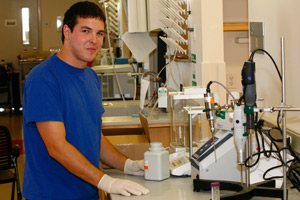 Adam Wiener1, Jose Viscarra1, Daniel E. Crocker2 & Rudy M. Ortiz1
Adam Wiener1, Jose Viscarra1, Daniel E. Crocker2 & Rudy M. Ortiz1
Type II diabetes is characterized by hyperglycemia caused by insulin resistance. Prolonged fasting is a natural component of the northern elephant seal’s (NES) life history, and is characterized by the maintenance of relative hyperglycemia and hypoinsulinemia. Under normal conditions, the absorption of circulating blood glucose by target tissues (i.e., adipose, skeletal, muscle, etc.) is facilitated by the proto-typical insulin-dependent glucose transporter, Glut4 In terrestrial mammals, extending fasting or starvation is associated with decreasing blood glucose levels and reduced Glut4 levels. We hypothesize that Glut4 expression will decrease in fasting elephant seals. We used western blot to quantify the protein expression of adipose levels of Glut4 between early(2-3 weeks post weaning) and late (<8 weeks post weaning) fasting seal pups. Seals were also given an iv glucose tolerance test (ivGTT) to evaluate their insulin responsiveness (a clinical test typically given to humans to evaluate for the presence of insulin resistance). The suppression of insulin secretion late in fasting with an ivGTT suggests that elephant seals develop insulin resistance during fasting. Despite the suppressed insulin response to the ivGTT, Glut4 expression increased with fasting suggesting that Glut4 may not be the prototypical insulin-dependent glucose transporter in seals. Alternatively, other undetermined factors may regulate the signaling pathway that regulates Glut4.

